Frog Vivariums, Page 2
Air Circulation
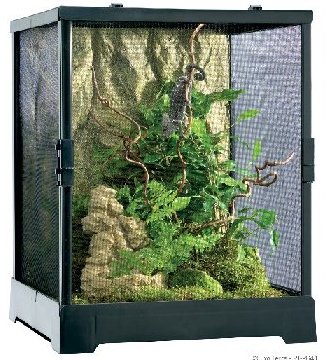 The air inside the
vivarium must circulate. Without the movement of air inside the set-up, it will
become stale and unliveable,. Fungus will multiply. You'll have dying and sick
frogs. So don't seal that top! Notice I said above a "loosely fitting" sheet
of acrylic or glass to hold in humidity.
The air inside the
vivarium must circulate. Without the movement of air inside the set-up, it will
become stale and unliveable,. Fungus will multiply. You'll have dying and sick
frogs. So don't seal that top! Notice I said above a "loosely fitting" sheet
of acrylic or glass to hold in humidity.
Always allow a cross-ventilation of air to occur. You can do this by drilling two 1" diameter holes on each of the two sides of the tank and covering with screen and gluing with silicone.
The Pool
 All frog and toad species will need a pool of water in the tanks' bottom.
This can be as simple as a shallow bowl of water,
or as advanced as a full-blown "waterfall and pond".
All frog and toad species will need a pool of water in the tanks' bottom.
This can be as simple as a shallow bowl of water,
or as advanced as a full-blown "waterfall and pond".
Stagnant water is unsuitable for the living conditions
of a frog. Daily water changes will be needed. If you are unable to change the water daily, the simple act of running an airline tube with an air stone placed at
the end and into the water bowl can go a long way towards frog health. (However, you will still need to change all water every other day) Buy some aquarium filter foam as shown to
your left. Cut a piece of it that is about 1" all around larger than your airstone,
 and cut a tiny slit up into it. Place the airstone up inside the slit. Weigh the foam
down in the pool with a river stone or two, leaving as much of the foam exposed as you can.
This will now act as a simple filter, and debris will tend to congregate
here! This helps keep water cleaner. Beneficial bacteria will begin to grow
here too, as long
as when you clean the sponge, you use treated water to do so!
If you use only the airstone without the sponge, clean the water every other day.
and cut a tiny slit up into it. Place the airstone up inside the slit. Weigh the foam
down in the pool with a river stone or two, leaving as much of the foam exposed as you can.
This will now act as a simple filter, and debris will tend to congregate
here! This helps keep water cleaner. Beneficial bacteria will begin to grow
here too, as long
as when you clean the sponge, you use treated water to do so!
If you use only the airstone without the sponge, clean the water every other day.
Even with the foam, change the water every other day unless you make a large pool and go through
the bacterial setup process, as shown on Water101. Frogs and
toads tend to rest in the pool in the evenings, and poop and pee in it.
Ammonia and waste buildup left in their source of water, then used by the frogs;
can cause irreversible kidney damage...another reason to keep water
clean.
For the utmost in clean filtered water, set up an
 algae tank.
algae tank.
Most submersible pumps do not come with filters either. I place foam around their intake too. It keeps them from clogging up with cricket chitin, which always seems to end up in the water chamber.
 If you're willing to go all out in the pool department, try using a piece of acrylic that is of the same
width as the inside of the tank, and "2 1/2" to "6"
inches high, depending upon the size of your frog when full grown. (See fig.6)
Using silicone glue, place this strip across the tank to the size you wish the pool to be
(the other side will be the land) Make sure the silicone has completely sealed the
pool area by testing with water before filling the other side in with substrate.
If it holds water, place an undergravel filter plate in as the source of water filtration.
Its a good idea to buy the filter plate before siliconing in the acrylic-this way
it will be the right size!
Many frog enthusiasts use this method for their vivariums.
If you're willing to go all out in the pool department, try using a piece of acrylic that is of the same
width as the inside of the tank, and "2 1/2" to "6"
inches high, depending upon the size of your frog when full grown. (See fig.6)
Using silicone glue, place this strip across the tank to the size you wish the pool to be
(the other side will be the land) Make sure the silicone has completely sealed the
pool area by testing with water before filling the other side in with substrate.
If it holds water, place an undergravel filter plate in as the source of water filtration.
Its a good idea to buy the filter plate before siliconing in the acrylic-this way
it will be the right size!
Many frog enthusiasts use this method for their vivariums.
If you add the undergravel plate, nitrosomonas and nitrobacter bacteria will "cycle" within time, and partial water changes will then become only a bi-weekly ordeal! Learn more about adding these beneficial bacteria by visiting the Water 101 page. Last but not least, never use untreated tap water in your pools, use bottled spring or treated water. Otherwise, you will poison/kill your pets!
Also a note to mention:
 Water fleas, or daphnias
and oxygenating plants can help provide a good environment for frogs. The fleas can
naturally be found in ponds as too the
algae. They help to clean up ponds affected by an excess of nutrients. Adding
them to your closed water system will give you some of the same benefits.
If you collect any water from a pond though, be sure
it is free of
Water fleas, or daphnias
and oxygenating plants can help provide a good environment for frogs. The fleas can
naturally be found in ponds as too the
algae. They help to clean up ponds affected by an excess of nutrients. Adding
them to your closed water system will give you some of the same benefits.
If you collect any water from a pond though, be sure
it is free of
 water scorpions,
water scorpions,
 water boatman
and
water boatman
and  dragonfly larvae.
dragonfly larvae.
Cleaning Up
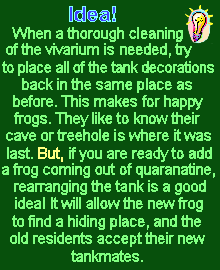 Depending upon the amount of frogs and the size of vivarium you have, you should
be maintaining the tank daily, and cleaning it thoroughly once
a month.
Depending upon the amount of frogs and the size of vivarium you have, you should
be maintaining the tank daily, and cleaning it thoroughly once
a month.
Daily maintenance would include removing any poops from the evening before,
carefully removing and wiping out clean with a paper towel, the water pool
and replacing with clean fresh spring or treated water.
(See  The Pool for
exact methods on maintaining water) If any poops are on the leaves in the
tank, peel them off and then mist the leaf, wiping any remaining
crud off. Wipe the
The Pool for
exact methods on maintaining water) If any poops are on the leaves in the
tank, peel them off and then mist the leaf, wiping any remaining
crud off. Wipe the

 seat patches with
spring water, and check for any dying plant material and remove.
seat patches with
spring water, and check for any dying plant material and remove.
Every month, remove the frogs and caves, branches, etc. Rinse clean foam substrate and/or river stone, or completely change "Bed-A-Beast" or natural moss. If using a living substrate and it is a false bottom tank, remove any now-exposed poos and pour water generously over the plants and substrate to release ammonia into tank bottom. If not a false bottom, peel the substrate back, and soak up the dirtied water with paper towels you wring into a bucket. This dirty water is great for plants, dump it onto them instead of down the utility sink.
Now use Quat, Nolvasan or

 Wipe Out
to mist the entire tank, including the sides
of glass, the screen top, etc. If your tank has no infection, parasitical or
fungal problem, you can lightly mist-rinse the tank in spring water half an
hour to an hour after spraying the Quat. While the tank
is soaking in the Quat or Nolvasan, make a bath of either of them and soak
the caves and branches in this bath. Rinse them in spring water before
returning to the vivarium. Replace any substrate material that you need to,
arrange the tank back and return your pets.
Wipe Out
to mist the entire tank, including the sides
of glass, the screen top, etc. If your tank has no infection, parasitical or
fungal problem, you can lightly mist-rinse the tank in spring water half an
hour to an hour after spraying the Quat. While the tank
is soaking in the Quat or Nolvasan, make a bath of either of them and soak
the caves and branches in this bath. Rinse them in spring water before
returning to the vivarium. Replace any substrate material that you need to,
arrange the tank back and return your pets.
Substrates
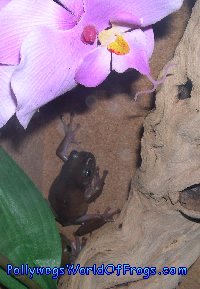 Substrates (gravel, sand, earth, sheet moss, etc.) vary in application and species being kept.
Substrates (gravel, sand, earth, sheet moss, etc.) vary in application and species being kept.
For froggers wanting a lot of natural plants, the use of a 2" layer of coarse gravel or round clay pellets on the bottom of the filter plate to start off the layering process. This is followed by a layer of pea gravel, approx. 1 1/2" thick. Atop this, add a 1" to 2 " layer of pre-moistened sphagnum moss. Now place the roots of your live plants into the sphagnum. Then add a layer of "Bed-A-Beast" or Scotts peat for a surface. (I prefer the peat)
Lastly, you can cover the entire bed with

 live moss.
or with
live moss.
or with

 dichondra. This multi-layer substrate creates
good drainage, an excellent growing environment for ferns, vines, and other plants,
and the living moss or dichondra on the top surface insures that your frogs will not have contact with
sphagnum moss or pea gravel, that could cause him to become
impacted. Incidentally, the Scotts peat moss will not impact them, because it is very finely ground.
dichondra. This multi-layer substrate creates
good drainage, an excellent growing environment for ferns, vines, and other plants,
and the living moss or dichondra on the top surface insures that your frogs will not have contact with
sphagnum moss or pea gravel, that could cause him to become
impacted. Incidentally, the Scotts peat moss will not impact them, because it is very finely ground.
Some frogs like leaf litter. Magnolia or oak leaves are good choices for those frogs. I would still layer the soils as mentioned above, just simply replace the moss or dichondra with the leaf litter instead.
One Method I use
First and foremost, allow me to mention that I do believe that frogs and toads benefit from the use of real, live plants that live naturally in their own corner of the planet! (Please visit Planting Vivariums and the page Frog Breeding.) From personal observation, they seem to acclimate better, eat as they should, breed as they should, and overall seem to have better health and longevity. From this, I try to combine the best of both worlds (use Scotts organic peat, real plants & silks) in order to make the frogs seem more at home and at the same time keep them viral/pest/disease/free.
I also use in tanks with sensitive frogs, a substrate containing a blend of dichondra grown from seed and live moss patches. The neat thing is, the seed and moss will grow right into a foam pad. This Organic Foam is also a good alternative for a top layer substrate, and The seeded foam can be rinsed under cool treated water to remove poop and ammonia, and then returned to the frogs' Vivarium. This is okay for frogs who don't burrow. If you are planning on a pacman frog, most bufos, kassinas, rain toads, and many other types of burrowing frogs, don't use the foam pad.
Before planting up the tank, I soak my plants; roots, leaves, stems and all in This Solution for one day (Fig.3). Then remove, rinse well in treated water, and plant up.
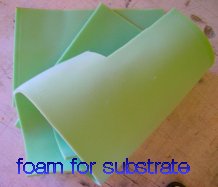 You can purchase the foam from Carpet-supply warehouses.
It has never caused any of my frogs any distress. It is also toxin-free .
Cut up several of the same size to fit the bottom of each tank,
then clean as each vivarium is broken down and cleaned up. Replace with some
of your pre-cut pads, and clean the one you've removed, including sterilizing.
To this foam-top add some sterilized & rinsed
river stone to weight the corners..this not only keeps the frogs from burrowing
underneath but their feeder insects as well. Remember, you can also plant dichondra
seed or moss into them.
You can purchase the foam from Carpet-supply warehouses.
It has never caused any of my frogs any distress. It is also toxin-free .
Cut up several of the same size to fit the bottom of each tank,
then clean as each vivarium is broken down and cleaned up. Replace with some
of your pre-cut pads, and clean the one you've removed, including sterilizing.
To this foam-top add some sterilized & rinsed
river stone to weight the corners..this not only keeps the frogs from burrowing
underneath but their feeder insects as well. Remember, you can also plant dichondra
seed or moss into them.
As a last remark, none of my normally healthy frogs have died under the two used above methods. Either two methods save me from the fear of impaction, and frogs are relatively safe from disease. With native plants and Scotts peat, the frogs live and breed.
Other Substrates
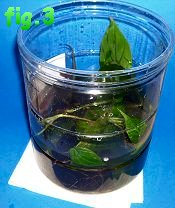 Other Froggers use (when properly changed out-quite a success rate!) dampened paper towels as a substrate material, as it is the easy to
clean and requires no false bottom. It is also great for bringing out morphling tadpoles
onto, provided one is careful to make sure humidity levels stay quite high and they are
changed daily to
remove ammonia/nitrite levels from frog poop and pee. Refer to the page
Water-101 for more info on ammonia and nitrates.
Other Froggers use (when properly changed out-quite a success rate!) dampened paper towels as a substrate material, as it is the easy to
clean and requires no false bottom. It is also great for bringing out morphling tadpoles
onto, provided one is careful to make sure humidity levels stay quite high and they are
changed daily to
remove ammonia/nitrite levels from frog poop and pee. Refer to the page
Water-101 for more info on ammonia and nitrates.
Some use live sheet moss and still others use Bed-a-Beast (a shredded bark-like mixture).
Whichever of the methods you choose, be sure to always invoke the old saying, Cleanliness is next to Godliness. This will go far in keeping your pets healthy.
The Vivarium Back Wall
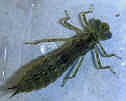 There are many great ways to beautify a vivarium through good planning of 'the back wall'.
They add depth and style, and functionability too. Small 'pockets' in them allow
for plantings of tiny ferns, pothos and the like. Treefrogs love climbing these
'walls' and lounging amongst the greenery. If they have a need to warm up, it also aides in getting them closer to the light source of the tank.
There are many great ways to beautify a vivarium through good planning of 'the back wall'.
They add depth and style, and functionability too. Small 'pockets' in them allow
for plantings of tiny ferns, pothos and the like. Treefrogs love climbing these
'walls' and lounging amongst the greenery. If they have a need to warm up, it also aides in getting them closer to the light source of the tank.
Some people like to use the plastic, pre-made walls. These can be purchased at herp Shops (also some Aquarium Shops) and take little time to install when you're starting from scratch. A 3' by 16" can usually be purchased for around $25.00.
If you've decided to use a pre-made wall, be sure to use silicone to seal the sides in . You don't want an inquisitive frog to find a small opening and get trapped back there. He may never find his way out and end up dying. Or you may forget he's there when doing a tank-cleaning! Remember, before adding anything additional, let the silicone dry for a minimum of 24 hours in a warm room.
Some froggers intentionally allow their frogs to get behind a backing. (They sleep there during their resting periods) I have not had luck with this, and so don't condone doing so.
Most froggers use a sheet of cork backing. You can attach plants to this medium too, and the real wood seems to make the frogs more comfortable.
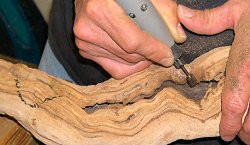 You can also use construction paper as a backing, just be sure to place it
on the outside of the tank.
You can also use construction paper as a backing, just be sure to place it
on the outside of the tank.
You can also make your own custom wall. There are many ways to go about this. One method involves using non-toxic earthern-red clays, another uses polymer clays, and the list goes on. For more on making your own walls, see Molding Rocks and Making 3-D Aquarium Backgrounds.
No matter which of the above ways you go, you should always supply a backing to your vivarium. It helps to make the frogs feel more at ease. A tank without a backing (we do three sides) leaves the frogs feeling vurnerable, and you'll most likely not see them as much as you'd like, as they'll stay hidden in their tree branches and caves.
The Plantings
Plants that work well in a vivarium would include some of the hardier varieties of ferns, bromeliads (for exotic treefrogs) and vines like those of the scindapsus family. Pothos is a common vine you can use with ease. Ferns should be sturdy varieties. "Birds' Nest fern" is a broad leaved, fast-growing variety.
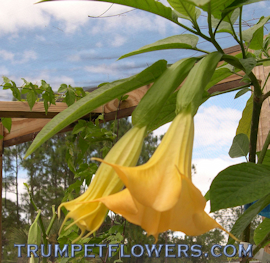 Tree ferns are good too, if you have a larger, taller treefrog-style setup.
Tame the roots of this fast-growing fern by potting it and sinking the pot into
the soil of vivarium, then every 6 months or so remove plant from pot and trim
roots with scissors. Replace in same pot. This will "bonsai" this giant fern a bit,
and give you a lush, tropical
plant to admire. Sturdy stems allow frogs good climbing access with the Tree fern too.
(It is a bit "hairy" on the stems, but the misting should remove any of this that
sticks to froggies).
If you're good with plants, low-light orchids like Phalenopsis work well too.
Tree ferns are good too, if you have a larger, taller treefrog-style setup.
Tame the roots of this fast-growing fern by potting it and sinking the pot into
the soil of vivarium, then every 6 months or so remove plant from pot and trim
roots with scissors. Replace in same pot. This will "bonsai" this giant fern a bit,
and give you a lush, tropical
plant to admire. Sturdy stems allow frogs good climbing access with the Tree fern too.
(It is a bit "hairy" on the stems, but the misting should remove any of this that
sticks to froggies).
If you're good with plants, low-light orchids like Phalenopsis work well too.
Vines that are to grow to any size may need to be trained. Home Depot, Lowes, and other Garden centers will carry Bark strips that you can use for this. Simply tie the plants loosely to the bark that you have propped up near back of vivarium. The vines will grow their roots into the bark. If you have a very large vivarium, or one that is very tall, you could consider a small hanging basket near the top that has a coconut bark lining. Fill with layered gravel, soils and then plant vines. This creates a lovely effect as the vine grows downward into the center of the vivarium. The treefrogs don't mind napping among the leaves either!
Cork sheeting or Cork tiles are also good to line the tank interior. Cutting either to size and adding to side and back vivarium walls will allow plants that vine a place to anchor roots, and your pets more security.
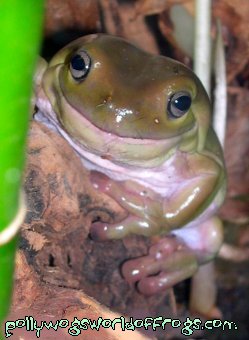 Just as a reminder, the plants need good air circulation, as
said before of the frogs. Planting
specific varieties from your frogs' homeland can be important if you really want a
good species-type set-up, or want to do the most possible to aid in breeding the
frogs.
Just as a reminder, the plants need good air circulation, as
said before of the frogs. Planting
specific varieties from your frogs' homeland can be important if you really want a
good species-type set-up, or want to do the most possible to aid in breeding the
frogs.
Plants for aquatic frogs become a somewhat unnerving issue. African clawed frogs are notorious for the disruption of anything that is not bolted down in their tanks, so using plastic plants will most likely be best with them. You can place them in shallow tupperwares anchored inside with stones. Slice a small hole in lide to allow vine to come through. This process will do away with the frogs being able to uproot the plants!
Learn more about individual plants and what climates/vivarium-setups they are appropriate for on the page Planting vivariums.
I outfit my African Clawed frogs and other aquatic species with special silk plants. (There is non-toxic plastic added to the 'plants' to make them more sturdy) Try finding them in Garden centers that stock outdoor fish pond supplies. They are much harder for the African Clawed frogs to rip away at their bases, and the floating "lily pads" are nice too.
You can use silks in the vivariums too. You could co-mingle living plants with them. This makes the silks more attractive. The bottom line is the comfort of the frogs. I know that my treefrogs prefer to sit on a live plant as opposed to a silk plant, so we co-mingle. If you are trying to breed a colony, make available some live plants to the frogs.
The watering of the plants in a vivarium should be done with spring, rain or treated water that is placed in a misting bottle. I do doubt you will need to water them heavily very often, if your set-up is in good working order. The natural evaporation caused from the pool should keep them moist, and unless you have a very large vivarium, misting should do the trick. Do this once or twice a week, and stop before you drench the soil. Over watering will cause the roots to rot, and fungi will appear to haunt you!
For more information on plants suitable for xenopus, see the page on Planting vivariums∼ pistia plant, papyrus and water hyacinth.
Plants that can harm frogs
Plants that can harm frogs include any that have sharp points on their leaves, plants with spines (like cactus) or any plant that could potentially break the frogs' skin and cause him damage. Choose carefully when shopping for live plants, touch them and look closely, thinking to yourself if there could be any danger in adding it to the frogs' home.
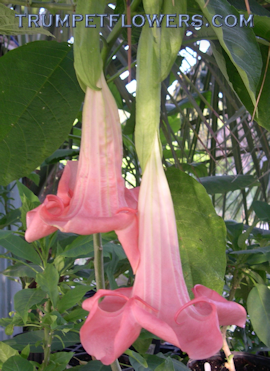 Dieffenbachia should not be used either. The common name is "Dumb cane".
The reason it is named so is that if you were to bite ever so slightly a corner of its'
leaf, the toxins in it would cause your inner mouth, throat and tongue to swell up for
over an hour...rendering you unable to speak...hence the word "dumb". Avoid
this plant with frogs.
Dieffenbachia should not be used either. The common name is "Dumb cane".
The reason it is named so is that if you were to bite ever so slightly a corner of its'
leaf, the toxins in it would cause your inner mouth, throat and tongue to swell up for
over an hour...rendering you unable to speak...hence the word "dumb". Avoid
this plant with frogs.
Some frogs, just like butterflies and a few other species of insects, also use poisonous plants to further their own posionous excretions. As an example, it is now thought that dendrobates cquire their toxins from the plants they rest on. That is why they lose this toxicity after being in captivity.
Supply List
Lastly, lets' make a shopping list for those of you starting out. When you do decide to purchase the tank, make sure to clean and rinse it out thoroughly. This will insure the frogs do not catch anything or are contaminated from something unseen. Properly sterilizing a new tank is addressed here: Sterilizing a New tank.
The List
Farenheight to Celcius Temperature
Need to Convert Celcius to Farenheit? Noaa.gov will help you out!
 Impacted definition, see
Glossary/impacted
Impacted definition, see
Glossary/impacted

 Glass cover must have small 'breathing holes' that are also screened.
Glass cover must have small 'breathing holes' that are also screened.


 10 gallons per frog is a good standard for medium-sized frogs. If you
are keeping dwarf pipids or other very tiny frogs, 5 gallons each should provide a good, stable environment.
10 gallons per frog is a good standard for medium-sized frogs. If you
are keeping dwarf pipids or other very tiny frogs, 5 gallons each should provide a good, stable environment.



 Organic soil needs to be used to avoid any pollutants or chemicals
that are almost always present in your local Gardenshop potting soil mixes. Here's an Online
Supplier: Wheat grass kits.com
Organic soil needs to be used to avoid any pollutants or chemicals
that are almost always present in your local Gardenshop potting soil mixes. Here's an Online
Supplier: Wheat grass kits.com




